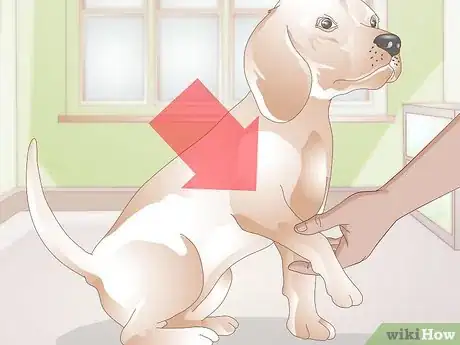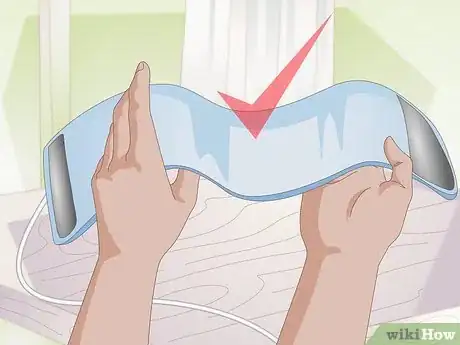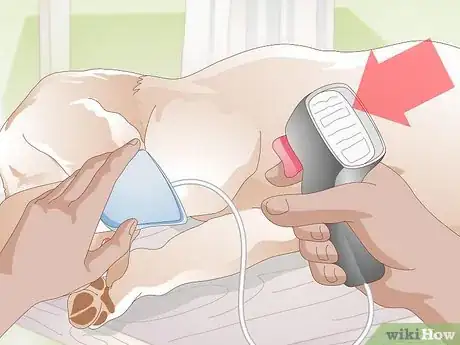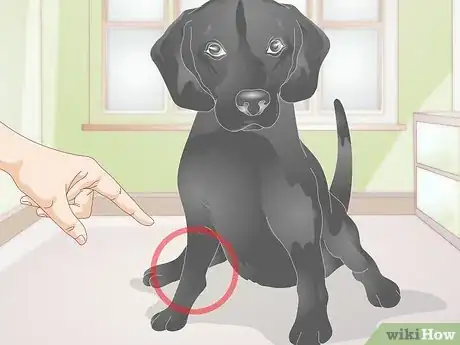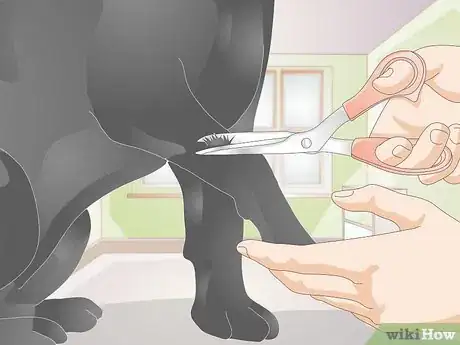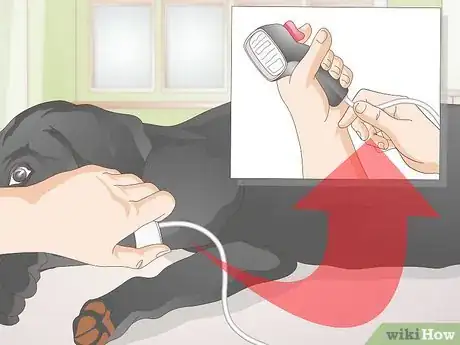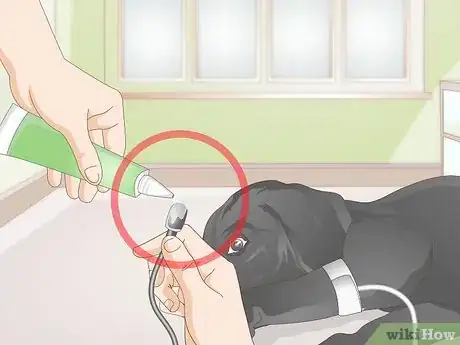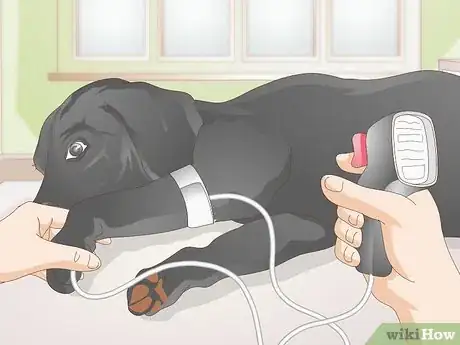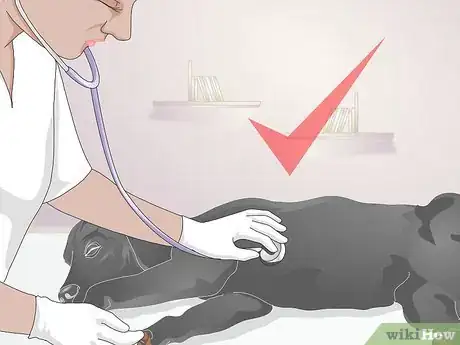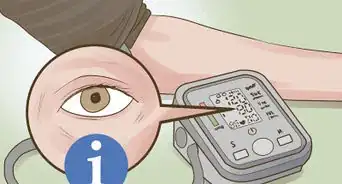This article was co-authored by Pippa Elliott, MRCVS. Dr. Elliott, BVMS, MRCVS is a veterinarian with over 30 years of experience in veterinary surgery and companion animal practice. She graduated from the University of Glasgow in 1987 with a degree in veterinary medicine and surgery. She has worked at the same animal clinic in her hometown for over 20 years.
This article has been viewed 81,430 times.
Your pet can suffer from hypertension (high blood pressure) just like a human can. However, dogs and cats do not typically have their blood pressure checked as part of a routine veterinary exam. The direct method of measuring canine blood pressure can only be performed by a veterinarian, but there are two different ways you can use the indirect method at home.[1] Though high blood pressure typically only affects animals over seven years of age, it's important to monitor your dog's health between veterinary visits. Learning how to take your dog's blood pressure can help ensure your canine friend remains healthy and happy for many years to come.
Steps
Testing Blood Pressure Using an Automatic Device
-
1Choose a measurement location. There are a couple of options for where to measure a dog's blood pressure. No location is necessarily better than any other; it's largely a matter of what the dog will allow and what is easiest for you to stabilize.[2]
- The cuff of an automatic device is usually administered around one of the dog's limbs or around the base of the tail.
- If using a limb, it's best to measure on the dog's right side at either the forearm (antebrachium) of the front limb or the outside of the hind leg.[3]
-
2Check the size of the cuff. Before you perform the test, you'll need to make sure the blood pressure cuff fits your dog correctly. A cuff that is too large often produces falsely low blood pressure readings, while a cuff that's too small will yield a falsely high reading.[4]
- The ideal size for a blood pressure cuff is approximately 40 percent of the dog's appendage circumference.
- When you lay the cuff flat against the leg or tail, the edges should be between 25% and 50% of the appendage's circumference.
Advertisement -
3Attach the cuff. Once you've determined that the cuff is the correct size for your dog, you can attach the cuff and proceed in taking a measurement. The cuff should be snug and secure without being too tight. It should be just snug enough that you cannot insert a finger between the cuff and the dog's appendage.[5]
-
4Inflate the cuff, then take a reading. Once the cuff is in place, the rest of the test is very similar to that of a human blood pressure measurement. You'll simply activate the automatic device, allow the cuff to inflate, then take the reading that the device gives you. The cuff presses against the dog's artery while inflated, and the pressure inside the cuff gets above the dog's systolic pressure. As the cuff deflates, the machine measures both systolic and diastolic blood pressure.[6]
- Hold the cuff (attached to the dog's appendage) at chest level on the dog, which should be approximately the height of the dog's heart.[7]
- The normal systolic blood pressure range is between 110 and 160 mm of mercury (Hg). Normal diastolic blood pressure lies between 60 and 90 mm Hg.[8]
- A dog has high blood pressure if its systolic blood pressure is consistently above 180 mm Hg.
Checking Blood Pressure Using the Doppler Method
-
1Choose a spot to take the measurement. Much like the automated device test, the doppler method requires you to choose a location to place the cuff. You can measure a dog's blood pressure on either its right front forearm, the outside of its right hind leg, or the base of the tail.[9]
-
2Trim the fur over the necessary sites. Whichever site you choose to take a measurement, you'll need to trim some of your dog's fur to get a more accurate reading. You shouldn't have to shave the fur, but you will need to carefully trim it down as short as you can safely get it without accidentally cutting your dog.[10]
- If you're using the right front forearm, trim the fur over the palmar metacarpal artery (just above the joint that hinges and leads to the paw, or the equivalent of a wrist).
- If you're using the right hind leg, trim the fur over the plantar metacarpals (the outside of the equivalent to the flat of a foot).
- For both the front and hind legs, you'll need to trim the fur under the paw (which is where the Doppler will be applied). You can use either paw, but the fur must be trimmed down between the pads of the paw.
- If using the base of the tail, trim the fur over the underside of the tail.
-
3Attach the cuff and connect it to the device. Once you've trimmed the fur, you're ready to attach the cuff to your dog's appendage. The cuff should be attached snugly and in place around the chosen appendage. It should not be too tight, but it should be snug enough that you cannot slide a finger under the cuff.[11]
- Connect the cuff to the sphygmomanometer to the cuff. Its base reading should show a pressure of 0 mm Hg.
-
4Apply acoustic gel to the Doppler probe. You will need to use acoustic gel with a Doppler probe. Acoustic gel is essentially the same gel used by doctors to perform an ultrasound.[12]
- The acoustic gel should be applied to the concave side of the Doppler probe, as this is the surface that will be placed against the skin.
- Once the gel has been applied, press the probe firmly against the skin above the chosen artery.
-
5Inflate the cuff and take a reading. With the cuff and Doppler probe in place, you're ready to take a reading. The Doppler probe works by inflating the cuff until blood flow is restricted in your dog's artery, then measuring the pressure at which blood flow is audible again.[13]
- The limb should be held approximately level with the dog's heart. This should be roughly at chest level if the dog is lying on its side.
- Inflate the cuff to about 20 mm Hg higher than the anticipated systolic blood pressure. You should not hear any whooshing sounds (arterial pulsations) at this pressure.
- Let the cuff slowly deflate and mark down the pressure at which you can hear the whooshing sounds again. This figure is the systolic arterial blood pressure.
Monitoring Your Dog for Health Problems
-
1Learn about common underlying conditions. There are a number of conditions that could cause hypertension in dogs.[14] Some, like obesity, can be treated with dietary and lifestyle changes. Others may require medication or even surgery to treat. Some common conditions that can cause high blood pressure include:
- chronic renal disease
- glomerular disease
- endocrine disease
- Cushing's disease
- diabetes mellitus
- acromegaly
- adrenal tumor
- polycythemia
- obesity
-
2Help your dog lose weight. Your dog's nutrition doesn't directly cause any health conditions that would lead to high blood pressure. However, a diet high in fat may cause your dog to become obese, which is a common cause of hypertension.[15]
- Check the nutritional label on your dog's food and any treats you commonly give your pet.
- Look for foods that are low in fat. You may want to consider restricting your dog's sodium intake as well.
- Give your dog plenty of exercise. Take your dog for at least one 30 minute walk each day, but be sure to bring plenty of water for your pet.
- Consider measuring and restricting how much food you give your dog with each meal. You can find charts that will help you determine your dog's ideal caloric intake by searching online.
-
3Schedule follow-up visits with your vet. If your dog has been diagnosed with high blood pressure, you'll need to schedule regular checkups with your veterinarian. Your vet will need to monitor your dog's progress over time and may recommend further dietary changes or medication.[16]
- Dogs with high blood pressure should have their blood pressure checked by a vet every few months.
- Your vet may recommend one or more medications, either to dilate the blood vessels (to lower your pet's blood pressure) or to treat the underlying condition causing hypertension.[17]
- Which medication your vet recommends will depend on how high your pet's blood pressure is and what underlying condition(s) your dog has.
References
- ↑ http://www.peteducation.com/article.cfm?c=2+2096&aid=3626
- ↑ http://www.vetstreet.com/care/blood-pressure-test-indirect-method
- ↑ http://www.cliniciansbrief.com/sites/default/files/ProP%20Blood%20Pressure%20Measurements.pdf
- ↑ https://www.dvm360.com/view/just-ask-expert-advice-proper-blood-pressure-cuff-size-and-placement
- ↑ http://www.cliniciansbrief.com/sites/default/files/ProP%20Blood%20Pressure%20Measurements.pdf
- ↑ http://www.vetstreet.com/care/blood-pressure-test-indirect-method
- ↑ http://www.cliniciansbrief.com/sites/default/files/ProP%20Blood%20Pressure%20Measurements.pdf
- ↑ http://www.peteducation.com/article.cfm?c=2+2096&aid=3626
- ↑ http://www.cliniciansbrief.com/sites/default/files/ProP%20Blood%20Pressure%20Measurements.pdf
- ↑ http://www.cliniciansbrief.com/sites/default/files/ProP%20Blood%20Pressure%20Measurements.pdf
- ↑ http://www.cliniciansbrief.com/sites/default/files/ProP%20Blood%20Pressure%20Measurements.pdf
- ↑ http://www.cliniciansbrief.com/sites/default/files/ProP%20Blood%20Pressure%20Measurements.pdf
- ↑ http://www.cliniciansbrief.com/sites/default/files/ProP%20Blood%20Pressure%20Measurements.pdf
- ↑ http://www.akcchf.org/canine-health/your-dogs-health/caring-for-your-dog/hypertension-in-dogs.html
- ↑ http://www.akcchf.org/canine-health/your-dogs-health/caring-for-your-dog/hypertension-in-dogs.html
- ↑ http://www.vetstreet.com/care/blood-pressure-test-indirect-method
- ↑ http://www.vetstreet.com/our-pet-experts/what-you-need-to-know-about-high-blood-pressure-in-pets?page=2
About This Article
To take a dog’s blood pressure, start by wrapping the cuff of the blood pressure device around your dog’s right forearm or the outside of its hind leg. Then, check that you're able to insert a finger between the cuff and your dog's limb to ensure that it's not on too tight. Next, hold your dog's limb at the level of its heart and activate the device to inflate the cuff. Finally, take the reading from the device to determine your dog’s systolic and diastolic blood pressure. To learn how to take your dog’s blood pressure using a doppler device, read on!
